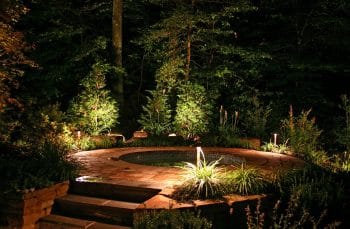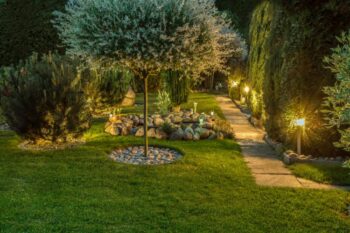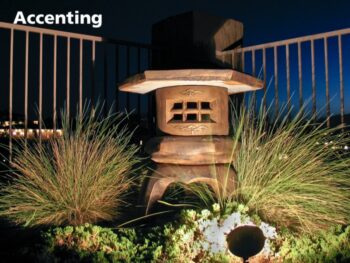When your home is perfectly landscaped with flowers, ornamental plants, and trees nestled throughout your property, the perfect finishing touch is some well-placed lighting. During the day, the bright colors and deep greens may look dazzling in the natural sunlight.
Why not ensure the beautiful yard you’ve cultivated is also visible for admiration at nighttime as well?
Landscape lighting can enhance your yard’s ambience almost as much as the plants themselves. A bit of ground lighting can create a soft glow or a dramatic appeal, depending on the placement.
Regardless of the season, this is a great way to nuance an already lovely landscape. Whether you’re facing the short, dark days of winter or the hot, forbidding days of summer, sometimes it’s more comfortable to enjoy your yard after the sun has set.
Where to Begin Lighting Your Landscape
The main thing to consider is what features you have available to you. Some features you may only want to highlight a little, or a large lit area at night for coverage that looks good and provides a sense of security.
 Map out your yard first. You can sketch your yard and the outline of your home on paper or use a landscape design app. Using the map, you can decide where lighting is necessary for safety, which features to highlight, and how to balance the spacing of the lights.
Map out your yard first. You can sketch your yard and the outline of your home on paper or use a landscape design app. Using the map, you can decide where lighting is necessary for safety, which features to highlight, and how to balance the spacing of the lights.
Explore your lighting fixture options. There are countless landscape lighting fixtures available, so be sure to thoroughly explore your options. You could use entry sconces, recessed lights, path lights, spot lights, flood lights, in-ground lights, pendant lighting, or even moon lights (which mimic the moon’s natural glow).
Need some help? Check out our service page for landscape lighting.
Be sure to include all features when planning your lighting:
- Buildings – Single-story or high walls might require more or less lighting. Lighting placement could be low towards the ground, or high above, depending on the preferred effect.
- Trees and Bushes – Trees with broader canopies might need multiple lights. Shrubs and bushes may only need a section of lighting for proper enhancement.
- Flower beds – Are great for low voltage lights, that shine enough light to enhance the flowers beautifully.
- Lawn decorations – Statues, flag poles, bird baths, centerpiece arrangements that you want to highlight.
- Fences and Pathways – These areas need light to clear a path or showcase a line of flowers along the wall.
- Patios & Decks – Keep these areas well-lit to enjoy some evening reading and create a relaxing mood.
- Swimming Pools and Ponds – Pool lighting is very important for safety reasons, and well-lit ponds allow for a calming place to enjoy the fish and the trickling waterfall.

Landscape Lighting Placement
By varying the distance and angle of the light fixtures, you can experiment with different lighting designs for unique landscape architecture goals. For example, trees often need two or more fixtures to provide sufficient illumination.
- Silhouetting – You can create an illuminated backdrop by placing a spotlight behind the feature, aimed towards an adjacent wall.
- Shadowing – Lighting aimed towards an adjacent wall can create a softer shadow, which often works best with a tree that has open, delicate foliage.
- Wall washing – Wall washing creates an even glow that reflects off the surface it’s aimed toward. Place the lighting fixture a few feet away from the feature, and give it a sideways angle. A wide angle flood light with low wattage is recommended for a more subtle effect.
- Up-lighting – Offering a greater contrast than typical wall-washing, spotlight fixtures are placed closer to a building for a bright and bold reflection.
- Moonlighting – Create moonlighting techniques by placing a large fixture with a full glare guard high up inside a tree, and angled downwards. It creates attractive shadow patterns on the ground, with a natural and indirect appearance.
- Down-lighting – Similar to the moonlighting technique, although brighter and less subtle. Set the lights higher if you want to illuminate a large part of the yard, and lower if you wish to illuminate a path or garden.
- Accenting – Any lighting that draws special attention to a specific feature is considered accent lighting. Specifically angled up-lighting or down-lighting can be used as accent lighting, to point out an architectural design, plant, or other feature.
- Path-lighting – Path-lighting is used for placing small fixtures along walkways, driveways, and patios.
Responsible Outdoor Landscape Lighting
It is possible to over do it, therefore don’t place lights on everything. Also consider your HOA guidelines and policies, as well as common courtesy for your neighbors when placing lights in your yard. You aren’t trying to mimic daylight, but visually enhance your lawn, garden and trees. Embrace the beauty of the shadows and subtle colors. Consider the indoor experience. When you’re working near windows, point lights away from the house, use softer bulbs, and focus the lights downward. This will prevent the light from glaring indoors and disturbing your family.

